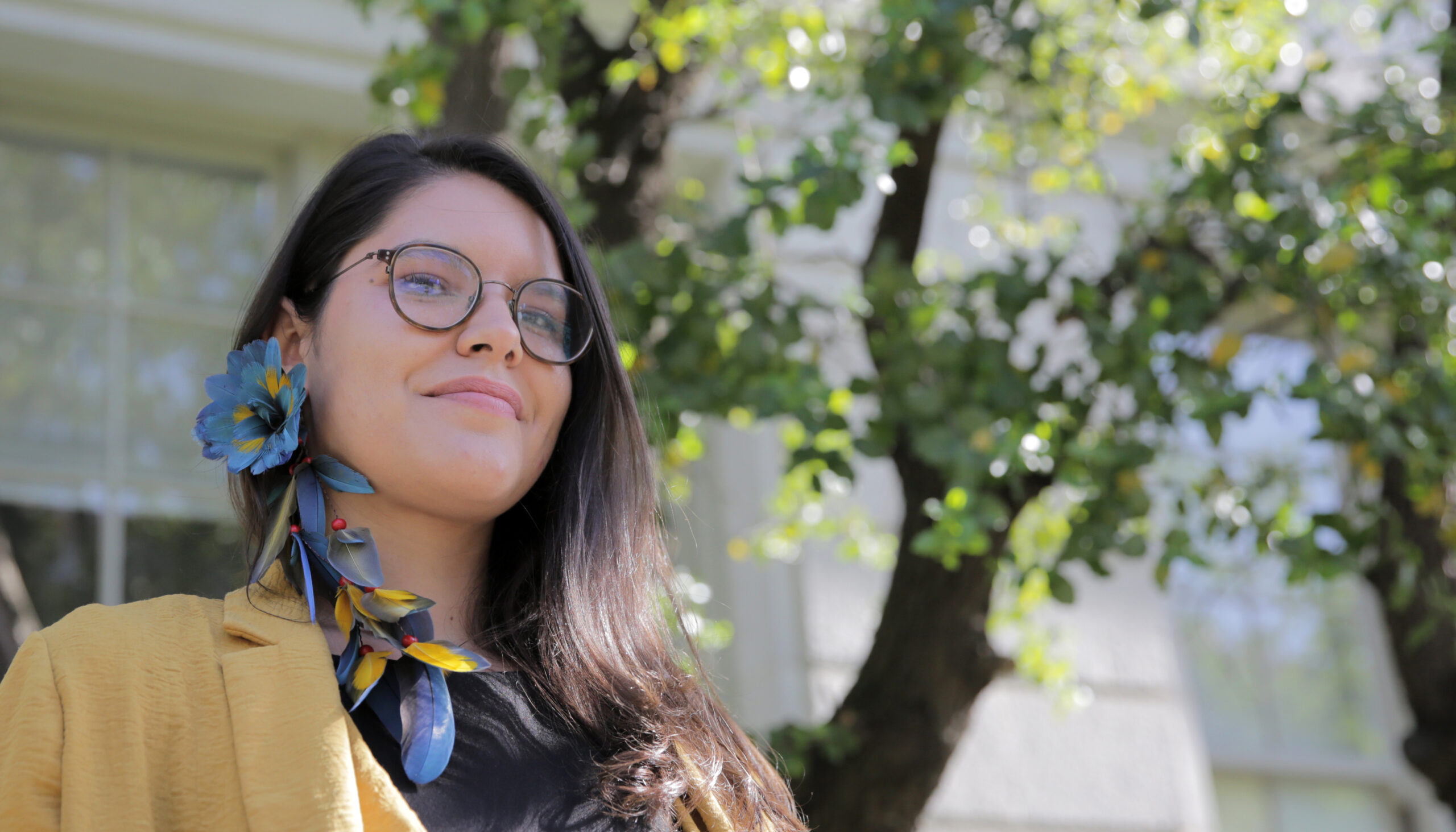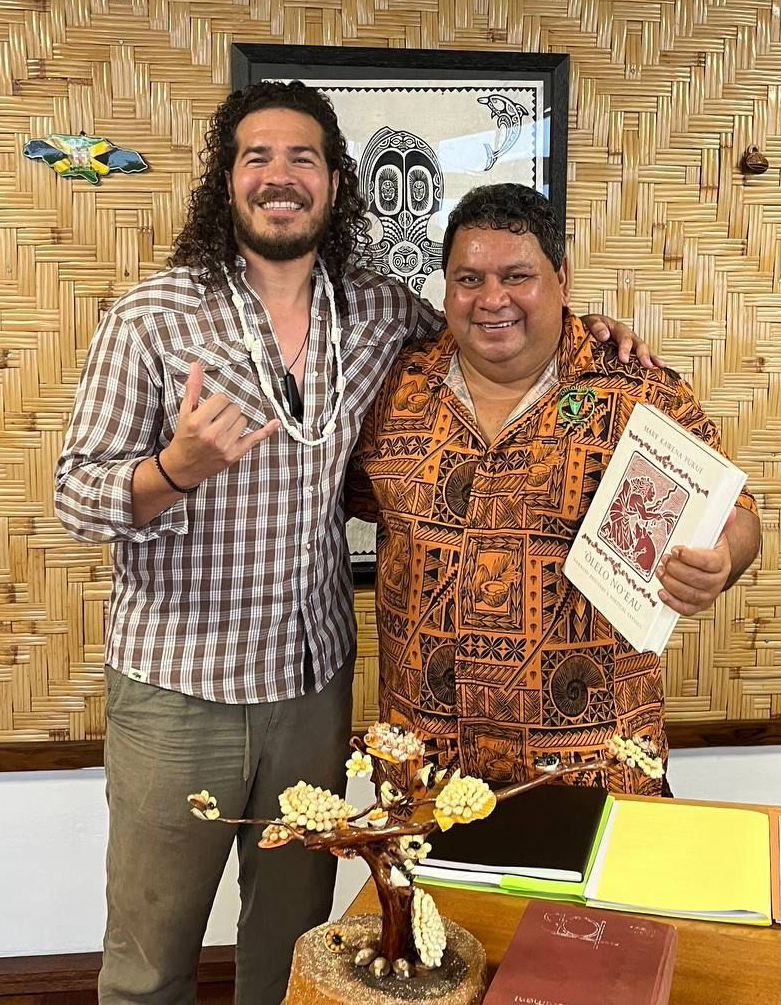Indigenous knowledge helps biotech find new drugs. This grad student wants those companies to give back.
Many successful drugs are based on medicinal plants used and stewarded for generations by Native communities. A UC Berkeley doctoral student says these communities should also benefit.

Robert Sanders, UC Berkeley
April 30, 2025
As a descendent of an indigenous Amazonian tribe, Maria Astolfi was concerned about research she conducted as a graduate student at UC Berkeley involving an extract of a plant long used for medicinal purposes by the Mapuche peoples of Chile.
The research in the lab of Jay Keasling, professor of chemical and biomolecular engineering, sought to reproduce in yeast a molecule from the Chilean soapbark tree that is used as an adjuvant or enhancer in many vaccines. A totally biosynthetic version of the chemical, called QS21, would avoid felling native trees to extract it.
But when Astolfi began working on the project a few years ago, she raised a sensitive issue that resonated with Keasling: Even though the gene sequences for QS21 and the soapbark enzymes that make it had been obtained from an online database, the researchers should not forget that the indigenous people of Chile had discovered the medicinal uses of the tree and stewarded the plant for thousands of years and hundreds of generations.
“If this product comes from traditional knowledge, and we are putting genes from that plant into yeast to manufacture them sustainably so companies don’t have to cut the trees in Chile, what about the community? What about the biodiversity in Chile?” Astolfi said. “Are there ways that the supply chain and the product that we develop can connect back to Chile and to that community? What are the best practices to do that?”
Back in the early 2000s, Keasling took a small step in that direction when working with another potential drug, prostratin, which is derived from the native Samoan mamala tree and thought to have potential as an anti-AIDS drug. Keasling and the UC Berkeley campus signed an agreement with tribal leaders in Samoa to divide equally any commercial proceeds from efforts to produce the drug in yeast. That research did not pan out, Keasling said. Nevertheless, he fully understood Astolfi’s concerns — he was just unsure how to address them.
“I think it’s good to put those ideas out in the world — that if a culture or people develop something through the years, and we find out what the active ingredient is, yeah, we should make sure they’re dialed into the compensation,” said Keasling, who is also a senior faculty scientist at Lawrence Berkeley National Laboratory and CEO of the Joint Bioenergy Institute (JBEI). “Educating their culture, getting them involved with it, all of these things help to raise the tide.”

Chris Schmauch Asilomar 2025 Courtesy Science History Institute
The discussion led Astolfi to collaborate with indigenous scientists from Hawai’i, Ecuador and Mexico, with the support of the Lab to Land Institute in Truckee, California, to explore how “to close the loop between what we do in the lab and stewardship of nature,” she said.
In a paper that appeared online March 27 in the journal Nature Communications, Astolfi, Keasling and their colleagues argue for a new type of partnership with indigenous peoples to create a more ethical bioeconomy, one that will sustain indigenous biodiversity and bring these communities into science as equal partners.
One of Astolfi’s co-authors was Keolu Fox, a Kānaka Maoli (native Hawai’ian) and assistant professor of anthropology at UC San Diego (UCSD). He co-founded a biotech company called Variant Bio that has cut revenue-sharing deals with more than 25 indigenous groups around the world to use their genomes to discover new targets for drugs. Partner communities have already received over $1 million, which Fox hopes will help them buy back land expropriated by colonizers centuries ago.
“We are providing 4% of proceeds from any revenue and intellectual property that we create, and we give free access to any pharmaceutical drug that hits the market,” said Fox, who is also co-founder of UCSD’s Indigenous Futures Institute. “That’s a path toward health equity. That’s a path toward cultural revitalization, having a place to speak your language. That’s a path toward nurturing and being a custodian of biocomplexity and biodiversity, which is ultimately a path toward climate resilience. It’s like, win, win, win, win, win. This is the first time anyone has ever done this.”
The paper holds up Variant Bio as one example of how biotech companies can be more ethical.
“Variant Bio and a company in the UK, Basecamp Research, are applying principles of benefit sharing in their pipeline as inspiration for socially responsible biotech businesses,” Astolfi said.
Benefit sharing
Astolfi’s mother is a member of the Kambeba/Omágua Nation, which lives on floating platforms along the often-flooded Amazon River. She grew up along the river, in Manaus, Brazil, and came to UC Berkeley as a graduate student in 2021, joining Keasling’s lab.

Courtesy Steven King
“I was born and raised in the Amazon rainforest in Brazil and grew up in awe of nature,” she said. “Since then, I have dreamed of translating biodiversity as a source of innovation. I believe nature has the answer for the most challenging diseases, but we haven’t explored its full chemical potential.”
Those dreams drew her to Keasling as a mentor. He is a pioneer in the field of synthetic biology, which involves adding multiple genes to microbes in order to tweak their metabolism to produce chemicals, including drugs, that they don’t naturally produce. The adjuvant QS21 is one such chemical that is now being commercialized by a large pharmaceutical company. Artemisinin, an antimalarial drug, was another. Keasling created a biosynthetic version that was eventually produced by Sanofi, a global pharmaceutical company that delivered 15 million free doses to Africa.
“The artemisinin commercialization was perhaps the first example of benefit sharing in synthetic biology,” Astolfi said.
Astolfi’s main focus in Keasling’s lab is using artificial intelligence to search genome databases and mine existing biodiversity for new drugs, work for which she received a 2024 BioEnginuity Impact Grant from Bakar Bio Labs, a campus incubator for life-science focused startups.
It has been estimated that 40% of commercial drugs today derive from plants and traditional medicine. The Nagoya Protocol, adopted in 2010 by many nations (though not the U.S.), laid out ethical and equitable ways for drug companies to use and acknowledge indigenous peoples that are a source of genetic material, whether from their own genomes or the genomes of plants or animals they use as food or medicine.
Yet such returns often come late in the process and don’t always benefit the broader indigenous groups, Fox said.
“These companies have a spotty record,” Fox said. “But benefit sharing is a great path forward. Not only does it speak to historical injustice and exponentially build trust, but it also improves the quality of the science. We have shown that you can expedite research and development by recruiting people faster and cutting through these data sets faster. And we’re parting with a percentage of the revenue, which is actually having an awesome impact on the quality of the communities that participate in our research projects long term.”

Courtesy of Keolu Fox, UC San Diego
Benefit sharing, the authors argued in the paper, can involve co-ownership of the intellectual property and sharing of licensing fees or royalties, but also co-authorship on scientific papers; investing in local development, including building local laboratories; conservation efforts; and equitable distribution of medicines. All of these can help sustain indigenous communities and cultures increasingly threatened by the environmental disruptions caused by the burning of fossil fuels.
“When we’re talking about creating circular economic feedback loops, this enables more land to be put into conservancy under the jurisdiction and guardianship of Indigenous people,” Fox said. “And that’s good for climate resilience.”
While philosophically open to these ideas, Keasling said that academic labs are usually involved at very early stages of research, far before any profits from commercialization. Since many DNA sequences come from online databases, it may not even be obvious which genomes are culturally significant. But he said it’s worth it to plan ahead to ensure that benefits accrue for indigenous communities.
“We usually work on molecules because somebody else has found that they are important,” he said. “But even at this early stage, that doesn’t excuse us from being a part of this.”
“If we’re able to commercialize QS21 in an ethical way, it can inspire the makers of other biodiversity-based products to do the same, and that would become a standard across the industry,” Astolfi said.
Other co-authors of the paper are Wari-Ňkwi Flores, co-first author and a native Ecuadorean Kara/Kichwa doctoral student at the University of Arizona; Rolando Perez, of Mexican heritage and a bioengineering researcher at Stanford University; Ulises Espinoza, a Latinx and Black postdoctoral research associate in anthropology at Princeton University; and Teal Zimring, executive director of the Lab to Land Institute in Truckee, California. The discussions that led to this article were funded and facilitated by Lab to Land.